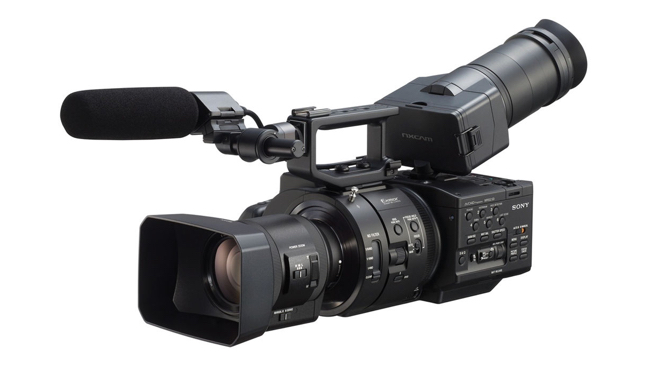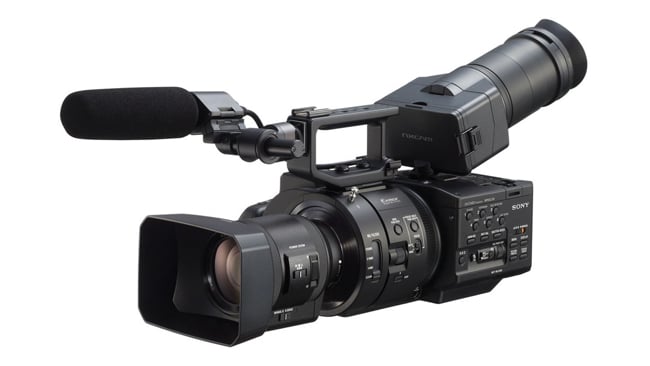
 Five years old but still worth considering all the same
Five years old but still worth considering all the same
Gear we like. It might be five years old now, which seems like a lifetime in the modern camera industry, but Sony's FS700 is still a mighty fine camera and that's even before you start talking about its high framerate capability.
It's inevitably a little disappointing that our Gear We Like appellation is generally only awarded only after a product has long since proven its worth and is, therefore, yesterday's news. Such is the case with Sony's seminal NEX-FS700 series. While they're still available new in the FS700R variant, the company would probably much rather we all bought FS5s instead and indeed, the FS5 is a very fine camera and includes many features missing from the FS700. Nevertheless, it has to be worth a moment's pause to consider any camera that started out recording HD and later received 4K and raw recording options. For the record, B&H currently sells the NEX-FS700R body for $3500. The R suffix indicates that the raw capability is preloaded, although buying one used might be the best way to go for anyone interested. They don't go bad.
The FS700's claim to fame, at launch, was its high frame rate capability. Concentrating too much on that feature, though, distracts from the other nice things about the camera. It uses Sony's E-mount, which is shallow enough to be adapted to essentially anything other than micro four-thirds. It is also compatible with the company's range of low-cost servo zooms. These are possibly now overshadowed in a world where the Zeiss 21-100 and Canon 18-80mm zooms exist, though they're far more capable in terms of zoom range and far more affordable than either. The 18-200mm f/3.5-6.3 PZ OSS lens is among the very best servo zooms, continuing to fill a crucial niche. The FS700 itself is small and light, and while the overall ergonomic layout is — to be extremely nice — questionable, there's a proper mechanical filter wheel and it shoots to low-cost SD cards.
To some extent, the low-cost recording was always the bugbear at launch. The FS700 is a far better camera than the NEX prefix suggests and the recordings, achieving around 20 megabits per second in reality, were frankly something of a let-down. It was a similar story as with the F3, although the FS700 uses MPEG-4 rather than MPEG-2. Given the early example of a three-gigabit SDI port, there was always the option to record externally, and it was widely taken up at a time when Atomos started to make some really attractive external SDI monitor-recorders. The Achilles heel of external recording on the FS700 is that the slow-motion feature, recording to an internal buffer, played out interlaced 60i frames. When de-buffering material shot at 240fps — meaning that no matter how carefully the output was recorded — the only way to get all of every frame was on that inadequate internal recording.
Thus it was absolutely astonishing to find that Sony later not only released the interface unit to make the FS700 compatible with the R5 recorder but also permitted Convergent to add FS700 raw compatibility to the Odyssey 7Q. Rather later — mid last year, in fact — Atomos would add support for Sony FS raw to their Shogun recorder, clearly targeting FS5 and FS7 users but incidentally providing the ability to record FS700 raw output to both CinemaDNG and ProRes.
Before these third-party solutions, the combination of the HXR-IFR5 and AXS-R5 wasn't anything even remotely like a low-cost update. A new HXR-IFR5 goes for $2200 (though B&H currently have one used for a bit more than half that) and the AXS-R5 for $5350 (again, used going for rather less.) The R5 takes ferociously expensive AXSM cards ($2500 for half a terabyte and you'll need a few). That should be seen in the context of its principal market of F5 and F55 users, as it mounts directly to those cameras. The Odyssey 7Q is considerably less expensive at $1795 and now supports selected Samsung SSDs to achieve something like commodity storage pricing, while throwing ProRes capture (and a rather nice 7-inch OLED display) into the bargain. A Shogun Flame is probably cheaper still and offers some nice HDR features as well.
Anyone purchasing an FS700 at launch would not have known that it represented possibly the best-value, most upgradeable camera ever released, starting off shooting HD to SD cards and ending up, potentially shooting 4K 12-bit raw at 120 frames per second in brief bursts. And that's proper 4096-wide cinema 4K, not this 3.8K UHD television stuff. Some external recorders make it possible to record 240fps in full cinema 2K for as long as the storage holds out, that being up to 45 minutes on an Odyssey. These are large and worthwhile numbers which have really only become available as standard features in the latest generation of cameras, five years later. Even the mighty Ursa Mini series tops out at 60fps in 4K.
The FS700 is in some ways a strange little box, but it has a reasonably well-positioned top handle, facilities for mounting rods and is still capable of images that wouldn't look out of place on more or less any project. As such, the Sony NEX-FS700 is Gear We Like, and a very worthwhile example for any manufacturer interested in keeping customers sweet with a piece of equipment that keeps growing with the state of the art.
Tags: Production


Comments